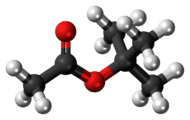tert-Butyl acetate
 | |
 | |
| Names | |
|---|---|
| Preferred IUPAC name
tert-Butyl acetate | |
| Other names
Acetic acid tert-butyl ester t-Butyl acetate | |
| Identifiers | |
| 540-88-5 | |
| 3D model (Jmol) | Interactive image |
| ChemSpider | 10446 |
| ECHA InfoCard | 100.007.965 |
| PubChem | 10908 |
| |
| |
| Properties | |
| C6H12O2 | |
| Molar mass | 116.16 g·mol−1 |
| Appearance | Colorless liquid |
| Odor | Fruity |
| Density | 0.8593 g/cm3[1] |
| Boiling point | 97.8 °C (208.0 °F; 370.9 K)[1] |
| 0.8 wt% at 22 °C | |
| Solubility in ether and ethanol | Miscible[1] |
| Hazards | |
| Main hazards | Flammable |
| Flash point | 22 °C; 72 °F; 295 K[2] |
| Explosive limits | 1.5%-?[2] |
| US health exposure limits (NIOSH): | |
| PEL (Permissible) |
TWA 200 ppm (950 mg/m3)[2] |
| REL (Recommended) |
TWA 200 ppm (950 mg/m3)[2] |
| IDLH (Immediate danger) |
1500 ppm[2] |
| Except where otherwise noted, data are given for materials in their standard state (at 25 °C [77 °F], 100 kPa). | |
| | |
| Infobox references | |
tert-Butyl acetate, t-butyl acetate or TBAc is a colorless flammable liquid with a camphor- or blueberry-like smell. It is used as a solvent in the production of lacquers, enamels, inks, adhesives, thinners and industrial cleaners. It has recently gained EPA volatile organic compound (VOC) exempt status.
It is manufactured from acetic acid and isobutylene.[1]
Butyl acetate has four isomers: tert-butyl acetate, n-butyl acetate, isobutyl acetate, and sec-butyl acetate.
See also
References
- 1 2 3 4 tert-Butyl acetate. Merck Index (11th ed.). p. 236.
- 1 2 3 4 5 "NIOSH Pocket Guide to Chemical Hazards #0074". National Institute for Occupational Safety and Health (NIOSH).
External links
This article is issued from Wikipedia - version of the 9/12/2016. The text is available under the Creative Commons Attribution/Share Alike but additional terms may apply for the media files.